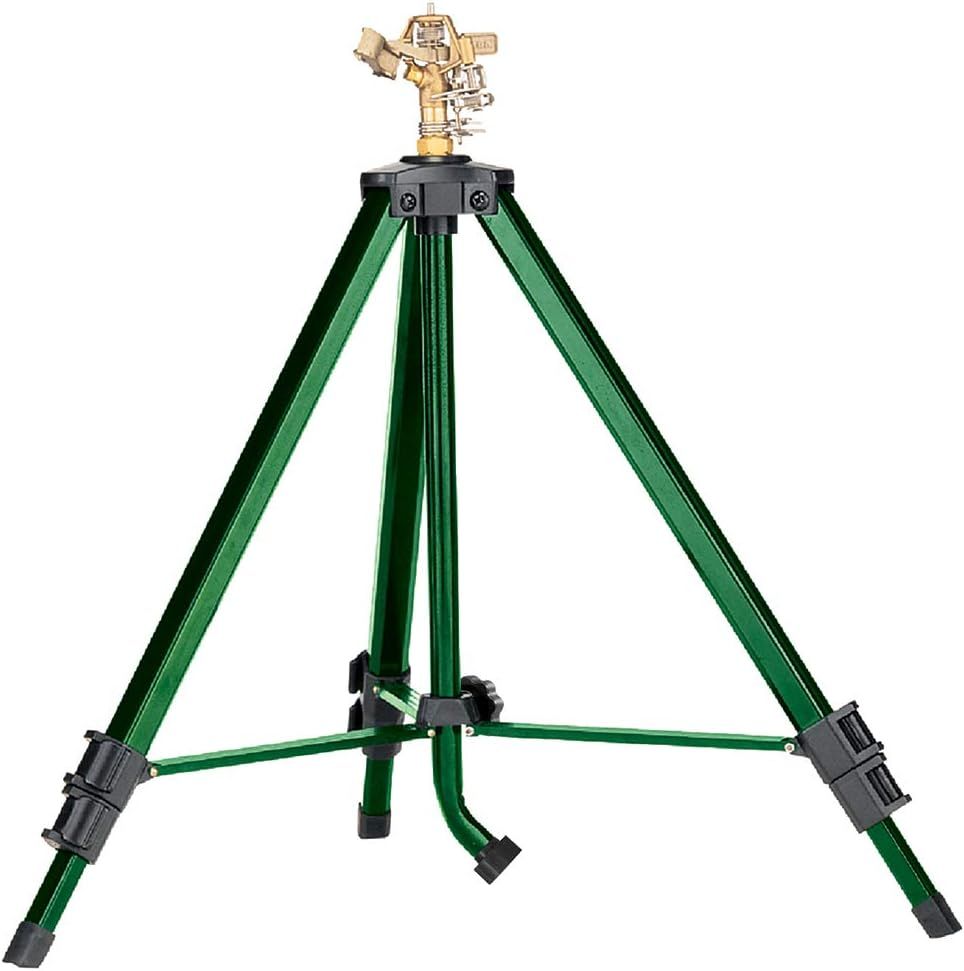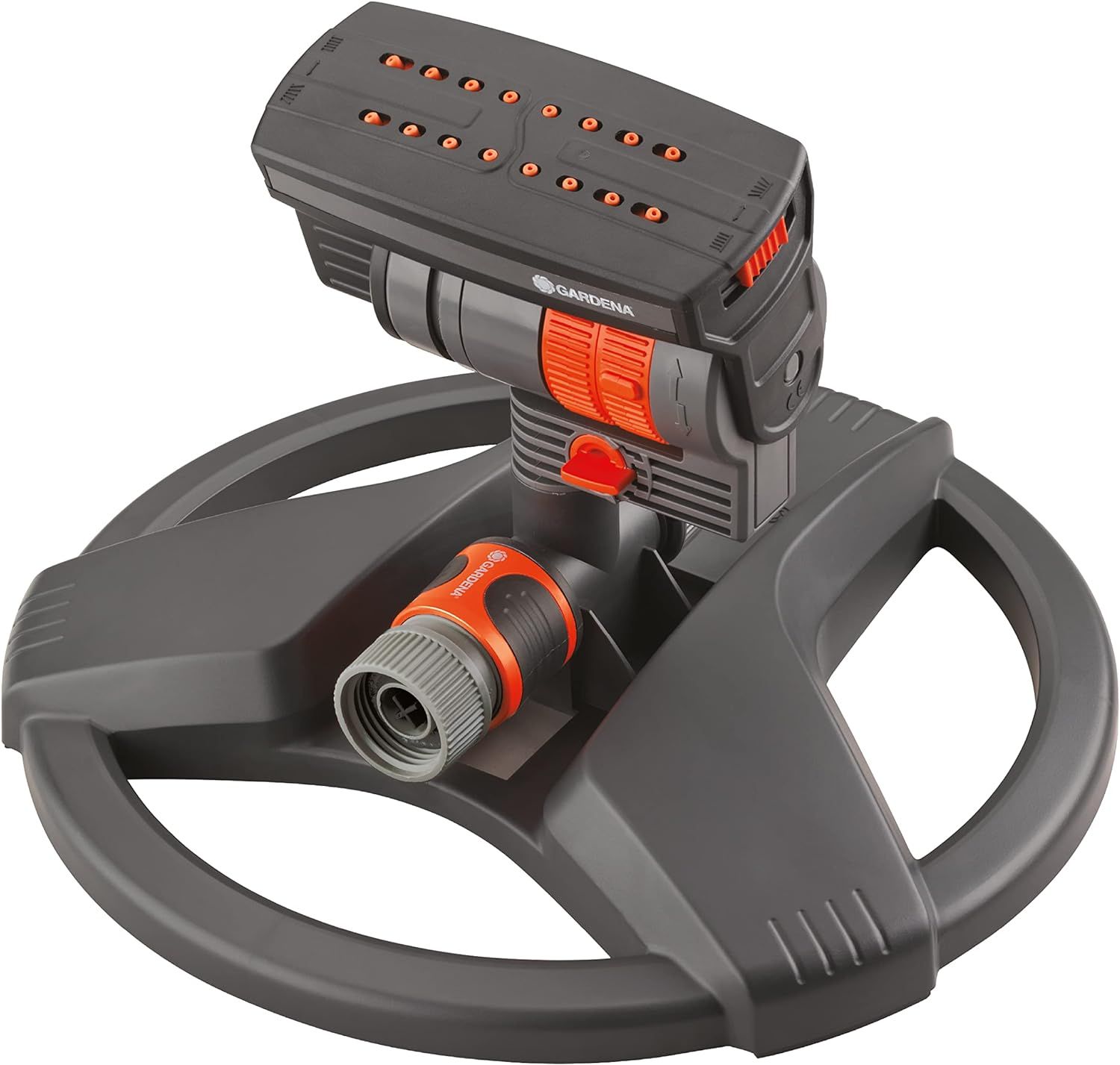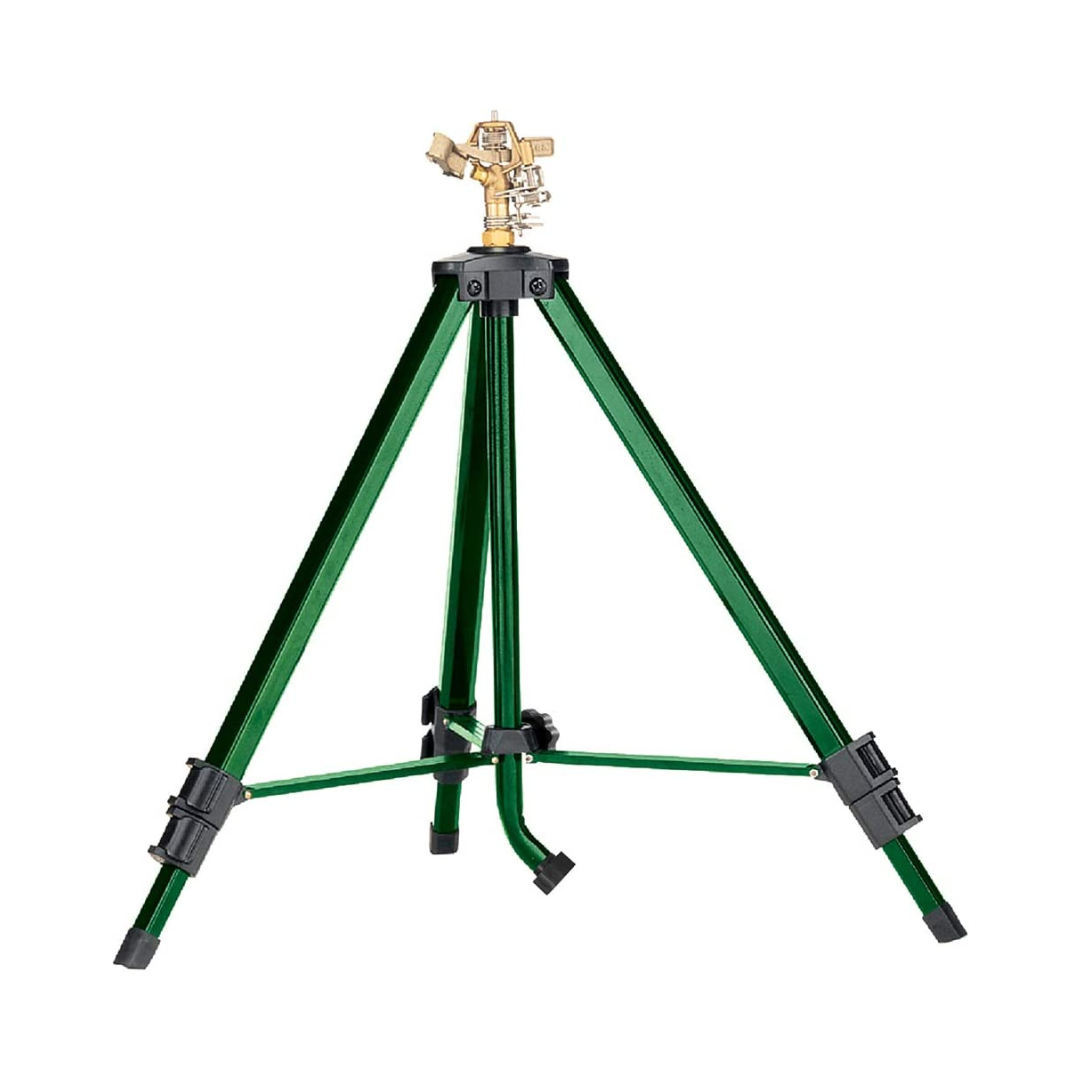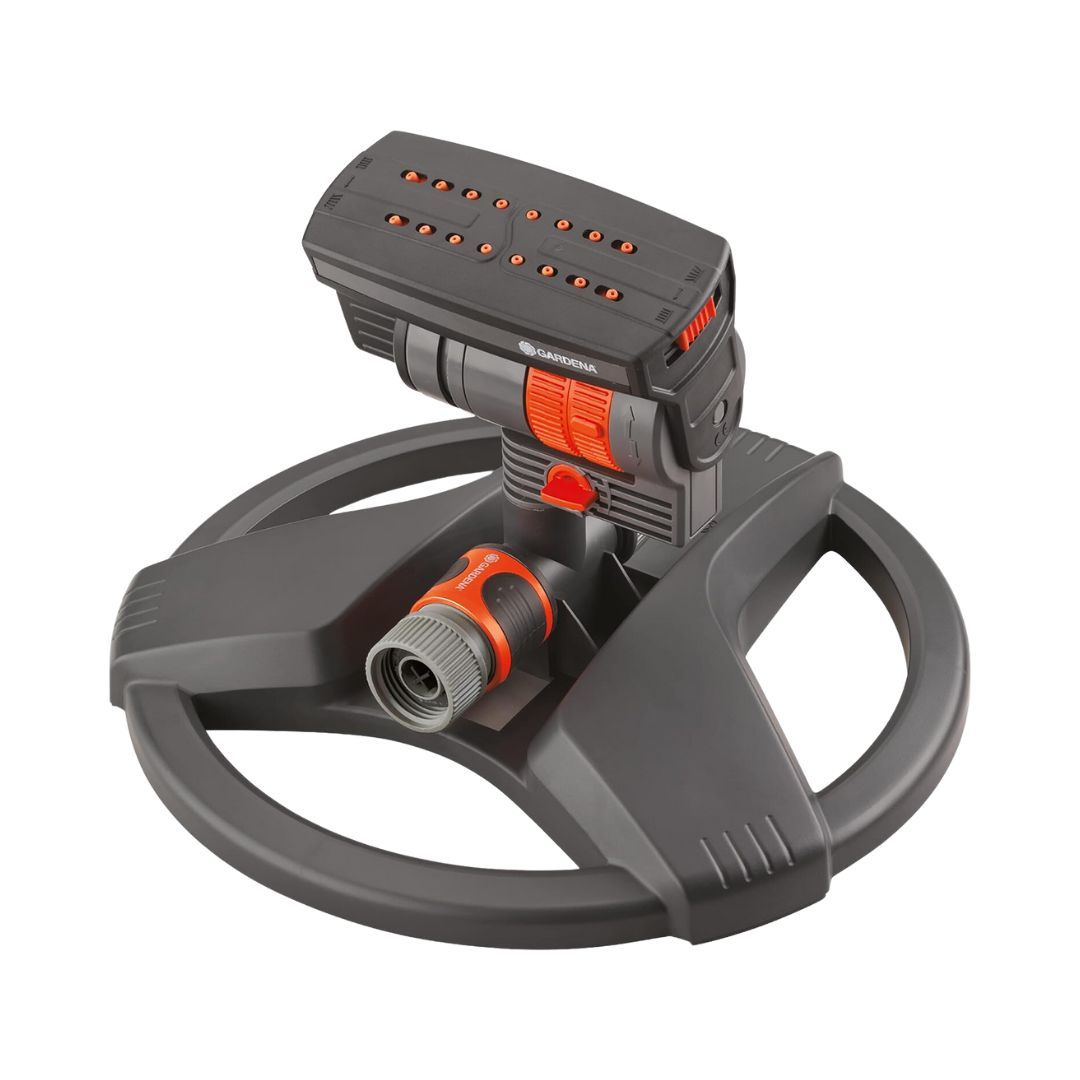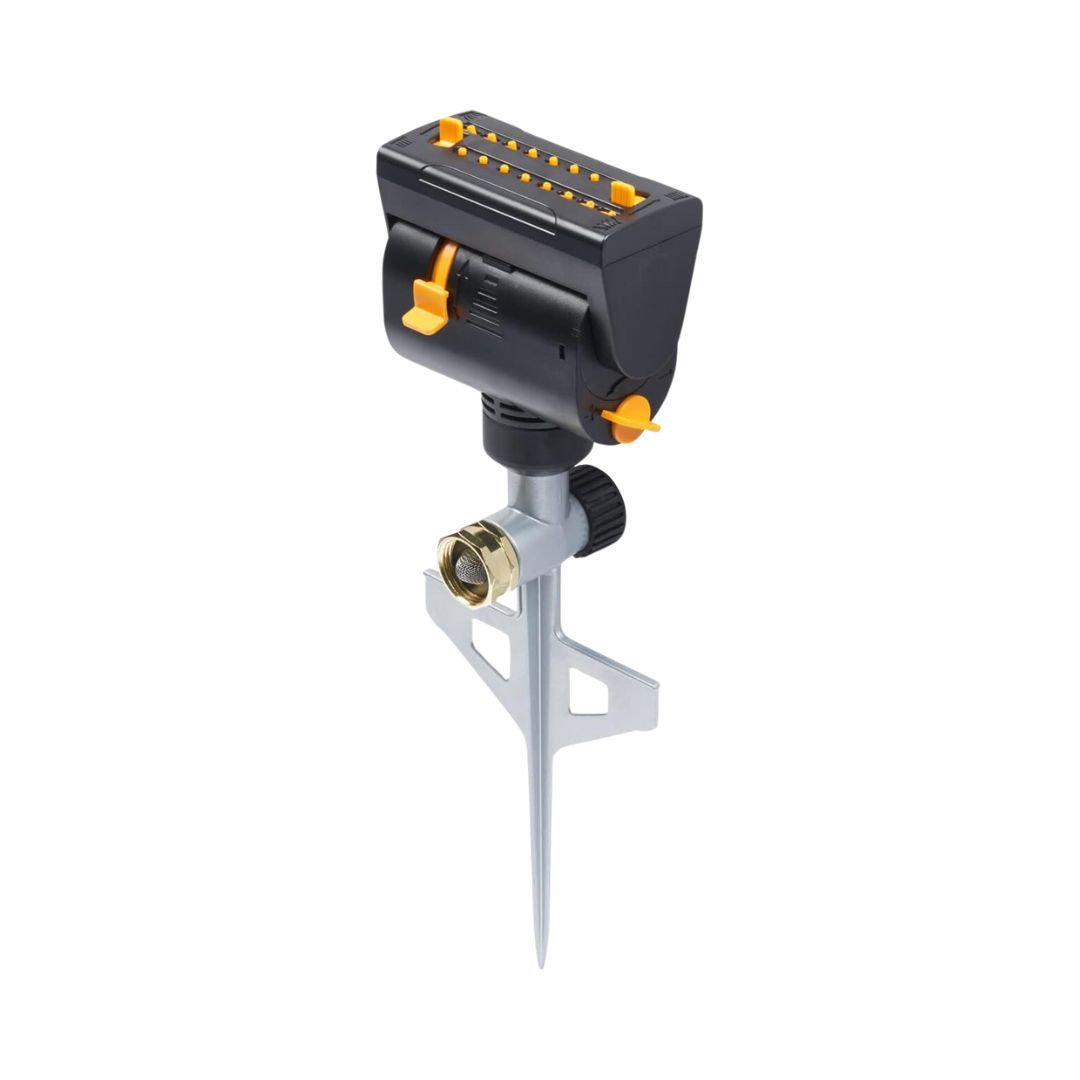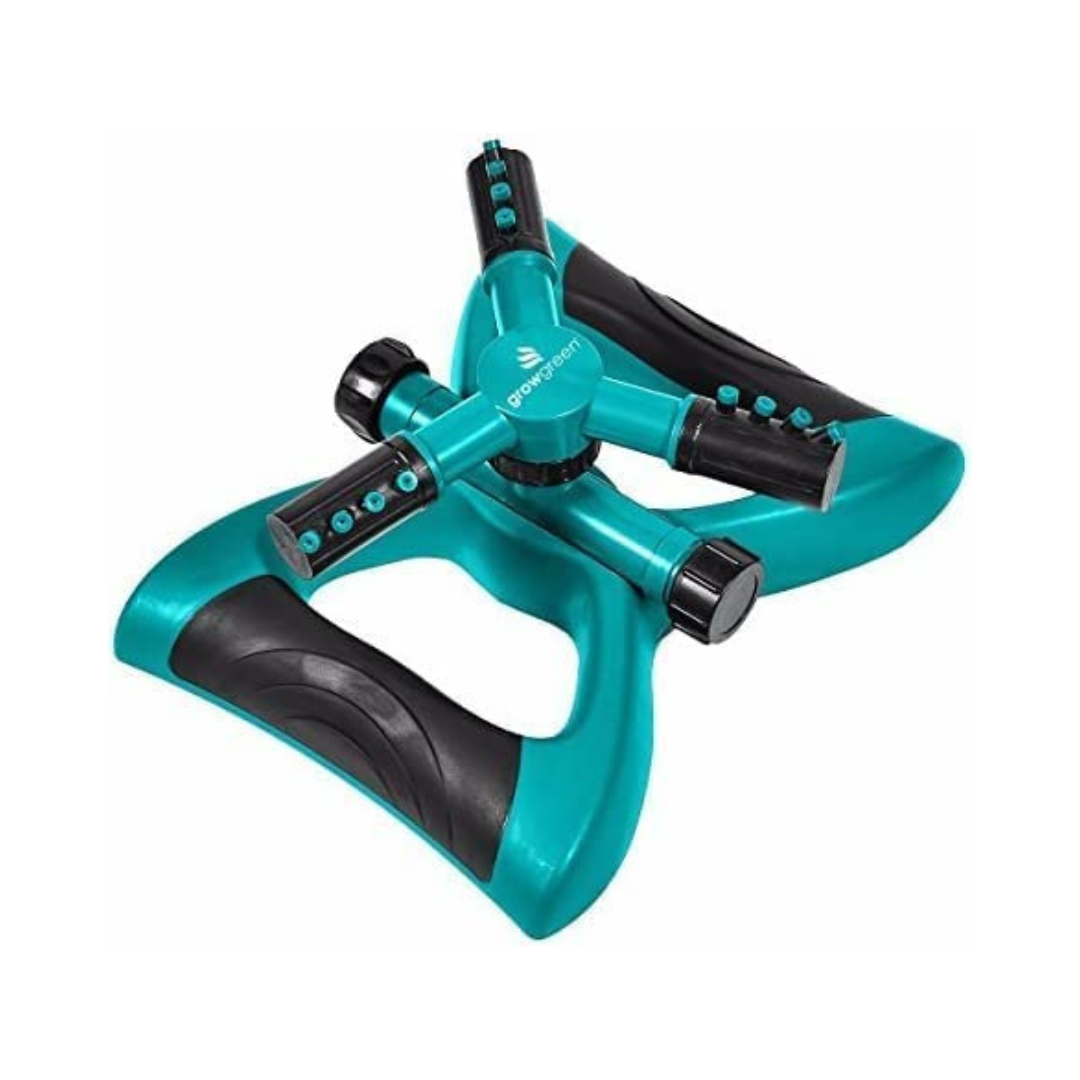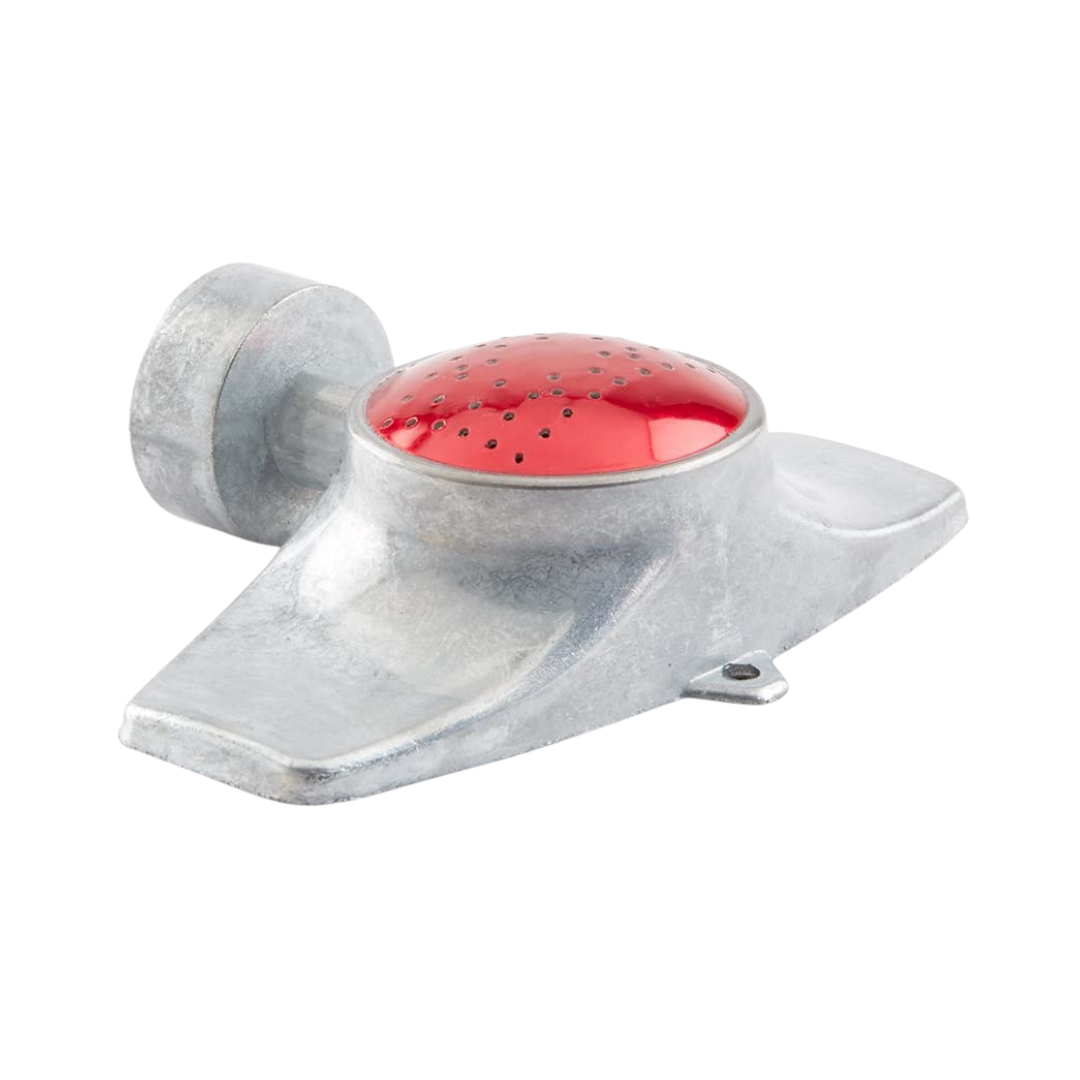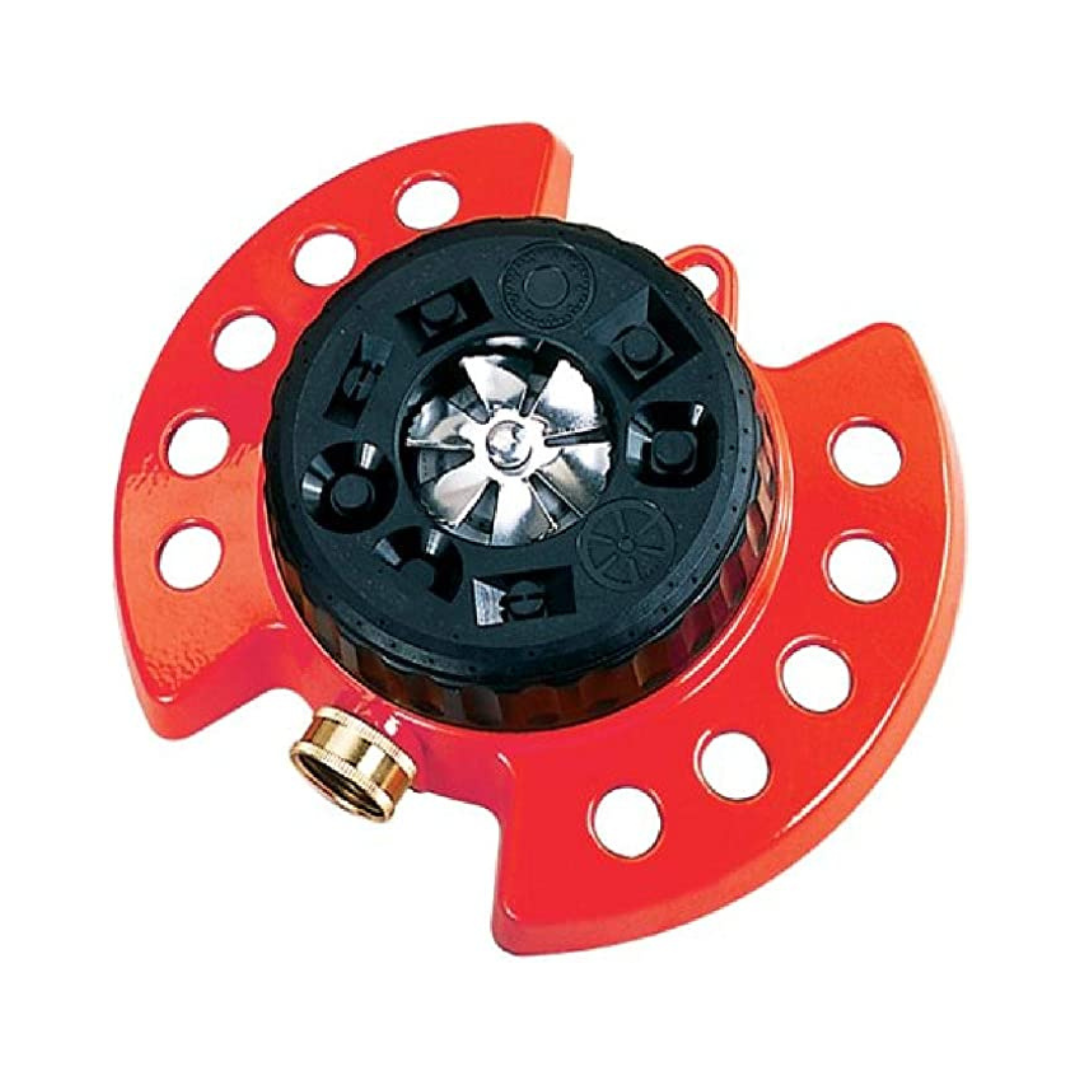We may be compensated if you purchase through links on our website. Our team is committed to delivering honest, objective, and independent reviews on home products and services.
Having a dense and colorful lawn starts with owning a quality sprinkler. However, sprinklers can vary significantly in price and performance, so there are several things you need to consider before finding the best one for your home, such as your law’s size, the type of climate you live in, and your hose setup.
You can find a high-quality sprinkler for as little as $10 for smaller lawns, but more heavy-duty sprinklers that cover large lawns and have adjustable settings can typically range from $30 to over $100. Overall, we recommend the Orbit Brass Impact Sprinkler for its heavy-duty bass, large coverage area, and adjustable settings. Read our guide below for more of our top picks
Best Sprinklers: Our Top 7 Picks
*Links open to product retail page.
- Best Overall: Orbit Brass Impact Sprinkler
- Most Adjustable: GARDENA Fully Adjustable Sprinkler
- Best Spike: Melnor Mini Turbo Oscillating Sprinkler
- Best for Large Lawns: GrowGreen Rotating Lawn Sprinkler
- Best for Small Lawns: Gilmour Spot Sprinkle
- Best Traveling: Nelson Traveling Sprinkler RainTrain
- Best Heavy-Duty: Dramm Duty Metal Base 9-Pattern Turret Sprinkler
Compare Top Sprinklers
| Product | Coverage | Style | Weight | Dimensions |
|---|---|---|---|---|
| Orbit Brass Impact Sprinkler | 6,360 square feet | Brass impact | 5 pounds | 15 x 9 x 8 inches |
| GARDENA Fully Adjustable Sprinkler | 2,300 square feet | Weighted sled | 13 ounces | 1.5 x 3 x 11 inches |
| Melnor Mini Turbo Oscillating Sprinkler | 4,000 square feet | Adjustable stake | 1.5 pounds | 2.75 x 14.2 x 4.9 inches |
| GrowGreen Rotating Lawn Sprinkler | 3,600 square feet | Rotating, adjustable | 1.6 pounds | 9.9 x 8.1 x 4.4 inches |
| Gilmour Spot Sprinkler | 450 square feet | Rectangular | 0.24 pounds | 5.8 x 4.4 x 1.5 inches |
| Nelson Traveling Sprinkler RainTrain | 13,000 square feet | Traveling | 17 pounds | 20.1 x 9.4 x 8.1 inches |
| Dramm Duty Metal Base 9-Pattern Turret Sprinkler | 575 square feet | Rotary | 0.9 pounds | 12 x 12 x 12 inches |
| Product | Coverage | Style | Weight | Dimensions |
Best Overall
Good for: Those who need to cover a large lawn and appreciate easy adjustability.
What Are People Saying About the Orbit Brass Impact Sprinkler?
According to our research, customers who gave this product positive reviews liked that it was highly maneuverable, excellent for large areas, and had a sturdy design. However, some customers who left mixed or negative reviews said that this product had difficult-to-follow instructions, while others felt it was not as sturdy as they were expecting.
“This is the lawn sprinkler that I have been searching for. Solid construction with fabulous range, I ended up buying a second one after testing out this one. Gone are the days of moving an oscillating sprinkler around; this one covers it all and more. Highly recommended.” — David via Amazon
“I was expecting something a lot more sturdy. I have to be really careful when setting the sprinkler up to make sure it is balanced perfectly or it will tip over from the hose pressure. The sprinkler itself is also rather flimsy.” — Amazon Customer via Amazon
Most Adjustable
Good for: Homeowners with a small or medium-sized yard that want to be able to quickly adjust the water flow.
What Are People Saying About the GARDENA Fully Adjustable Sprinkler?
Our research showed that customers who liked this product were impressed with its durable build and straightforward setup. Others also commented on its easy adjustability settings. On the other hand, we noticed that some reviewers found this sprinkler to have low water pressure, and others said they felt the plastic pieces could lead to durability issues.
“The four directions of independent adjustability on this sprinkler is wonderful. I have a narrow side yard that the average sprinkler will cover but, will also soak the house and water my neighbor’s yard…. That’s why this sprinkler is so wonderful. I’m able to adjust the side-to-side spray as well as the distance as it oscillates to ensure the correct coverage of new grass that was planted and my small garden.” — J.D. Clymer via Amazon
“The reason I bought this sprinkler is for durability and coverage area. Seems to be fair-good quality, and the spray is nicely adjustable and covers a large area. The hose connector is easy to use too. However, a lot of the construction is plastic, and I question if this will last over time. We shall see.” — chris biss via Amazon
Best Spike
Good for: Customers looking for an easy-to-use sprinkler that can be staked into the ground.
What Are People Saying About the Melnor Mini Turbo Oscillating Sprinkler?
Customers loved how adjustable this sprinkler was, with the settings being especially useful for those with smaller lawns. Others also liked that they could control the water flow, in addition to the direction. However, some questioned its durability in harsh weather, and others said they had issues with the sprinkler leaking.
“This is exactly what I needed! I live in a town home and have a small strip of grass in the front. Every other sprinkler over-sprayed into the street and into mine and my neighbor’s driveways. This allowed me to set it very specifically to water only my small strip of grass without all of the extra water everywhere. I wish I had found this sooner. Highly recommended if you are looking to water a small or oddly shaped area. Really allows you to tailor the spray length and width.” — Brandi S via Amazon
“This sprinkler system seems like it is great for every need. There are several adjusters on this. You can control the range with the main lever on the front. The top controls how wide you want. You can do narrow on one side and really wide on the other side. And of course you can also control the water pressure. …When using the lower pressure I would not recommend having on if it is windy. The stream was compromised. Also, with everything plastic I wonder how many seasons this will last. I will be surprised if this lasts more than one season.” — Ramgo via Walmart
Best Sprinkler for Large Lawns
Good for: Those who need extra coverage for dry spots on medium or large lawns.
What Are People Saying About the GrowGreen Rotating Lawn Sprinkler?
Our research indicated that the majority of customers liked this sprinkler’s versatile design and its ability to cover large areas. It also earned rave reviews for its colorful, stylish design. However, we also found that some customers felt this sprinkler wasn’t as durable as some competing models, and others had issues with it spraying in an uneven pattern.
“For me, this sprinkler worked best compared to others. I have a pretty small yard. Rotating sprinklers would keep getting stuck and stop rotating. It was also hard to dial them in and keep the water in my yard. This style sprinkler would easily work for a larger yard also, but for me I can dial down the water flow and keep the water where I need it.” — Gello via Amazon
“I ordered this sprinkler because I thought it would give me a better watering radius than the sprinkler I currently have. I was wrong – I tried upping the water pressure, but all I really got was basically a decorative fountain in my backyard. It was covering maybe a 7-8 foot radius, not nearly what I need. It also feels really cheap and will crack at the slightest of hits.” — Kerry via Amazon
Best Sprinkler for Small Lawns
Good for: Homeowners who only need minimal coverage for a small surface area.
What Are People Saying About the Gilmour Spot Sprinkler?
We found that customers who left positive reviews for this product liked that it was well-designed, had a light weight, and worked excellently on small lawns. However, our team also learned that a few critical customers said it was actually too light to work effectively and needed to be weighed down when in use, and other felt it used too much water.
“This sprinkler is convenient for watering small portions of the garden. It has a low price, seems sturdy, all metal, and is simple to use. Can adjust range of sprinkler my adjusting the hose bib for pressure. This is a convenient simple yard tool. Recommended.” — Dad in Texas via Amazon
“I wanted a rectangular-shaped sprinkler pattern with no moving parts to break, and this fit the criteria. I want to love this thing, but as others have stated, it’s very light, so you have to finesse your hose in just the right way to ensure it’s laying flat and stays that way (or use a stake to pin it). The pattern is definitely rectangular-ish in my experience, and the coverage adjusts depending on the volume of water just fine.” — BRuiz via Amazon
Best Traveling Sprinkler System
Good for: Those who need a sprinkler for commercial use or extra-large yards.
What Are People Saying About the Nelson Traveling Sprinkler RainTrain?
Our team learned that positive customer reviews often praised the RainTrain for its heavy-duty construction and the option to fine-tune its motion settings. However, our research also revealed that a couple of buyers were dissatisfied with the coating, which they stated failed to prevent rust from forming after prolonged use. Others said that it was ineffective on uneven grass.
“Best sprinkler I’ve ever had for the lawn, and I’ve tried them all in the past 30 years. Sturdy, stable and reliable. Goes over uneven parts of the yard and is able to easily adjust from grass to cement sidewalk and back to grass. At first I kept an eye on it but now I can put it out and be confident it will cover everything. It takes about the same amount of time on the fast setting as a regular sprinkler except you do not have to move it around.” — Trish via Amazon
“This is a decent enough tractor sprinkler. It’s able to handle up to 200 feet of hose before the weight of the hose is too great. It isn’t the right choice for gardens or uneven lawns or tall thick grass. If the ground is uneven or the grass is too tall, it will push on the sensitive cutoff plunger on the bottom of the sprinkler. The plunger is made to cut off water when the sprinkler runs over the included ramp, which fits on the hose. Even though our grass is mowed, I have to occasionally restart my sprinkler because our yard is uneven and has thick knots of grass.” — bk via Amazon
Best Heavy-Duty Sprinkler
Good for: Customers looking for a durable sprinkler that’s easy to store.
What Are People Saying About the Dramm Duty Metal Base 9-Pattern Turret Sprinkler?
We learned that customers who gave positive reviews to this product liked that it had a sturdy base, came in a variety of colors, and had several water patterns to choose from. On the other hand, others felt that it had lackluster spray coverage, and others found the settings difficult to understand.
“This is not your ordinary plastic sprinkler. It is made using metal parts and it is extremely strong and durable. Be aware, however, that this sprinkler does not cover a great deal of area. It is better to think of it as a versatile small-area sprinkler. It is perfect for small areas, and it has numerous settings to customize the pattern of the flow of water.” — Stephen K. via Amazon
“Well-made metal sprinkler and works nicely in the very small areas of my yard, but the overall coverage is very weak. It sprays in about a 6-7 feet diameter. I even had my engineer son take a look at it because I thought something was wrong, but all the settings produce similar coverage. I’m keeping it for use in my side yards, but trying to use it to water the rest of my 30-by-75 yard would take hours, so I’m looking for yet another sprinkler to do that job.” — Stephen K. via Amazon
Types of Lawn Sprinklers
Sprinkler systems are designed to distribute water evenly across your lawn or garden, mimicking natural rainfall. These systems use water pressure to operate their internal mechanisms, spreading water over a designated area without flooding any single spot.
Most sprinklers can produce a water flow that ranges from a light mist to heavy rainfall, with many models offering adjustable settings. The choice between individual sprinklers and full sprinkler systems depends on your lawn size, budget, and desired level of automation.
From standalone sprinklers that attach to a garden hose to complex in-ground systems, there’s a wide range of options available to suit different needs and budgets.
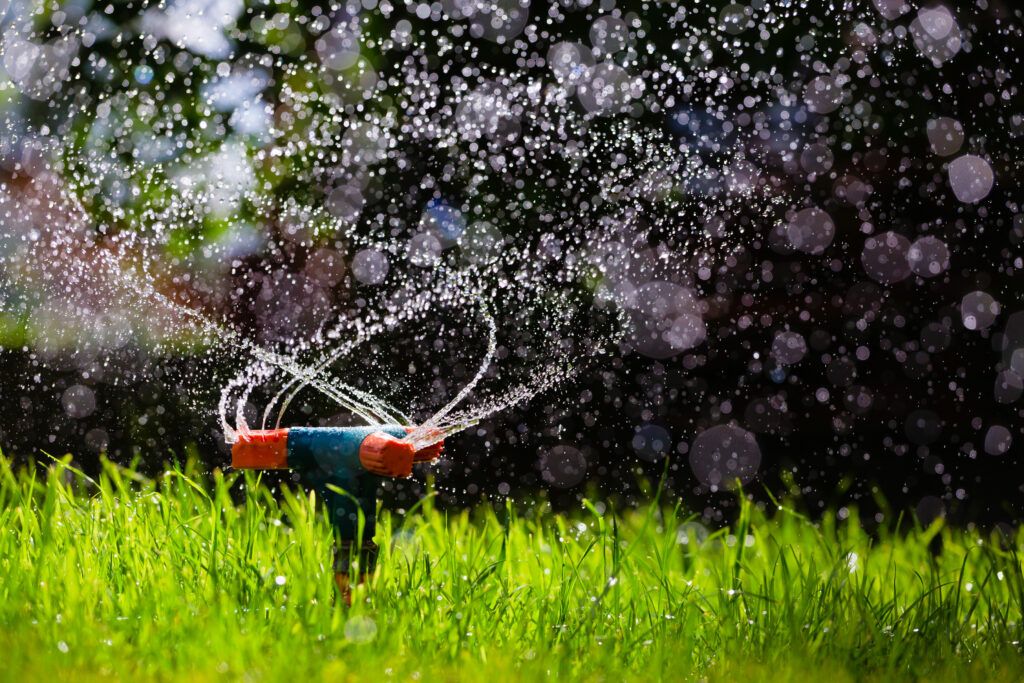
Rotating Sprinklers
Rotating sprinklers are versatile and popular for their ability to cover circular or square areas. They typically feature arms with nozzles attached to a rotating spindle, spraying water in symmetrical patterns. These sprinklers are ideal for small to medium-sized lawns and can be adjusted to provide anything from a gentle mist to heavy rainfall.
- Reach: 50 to 60 feet in diameter
- Spray pattern: Circle or square
- Watering speed: Slow to very fast
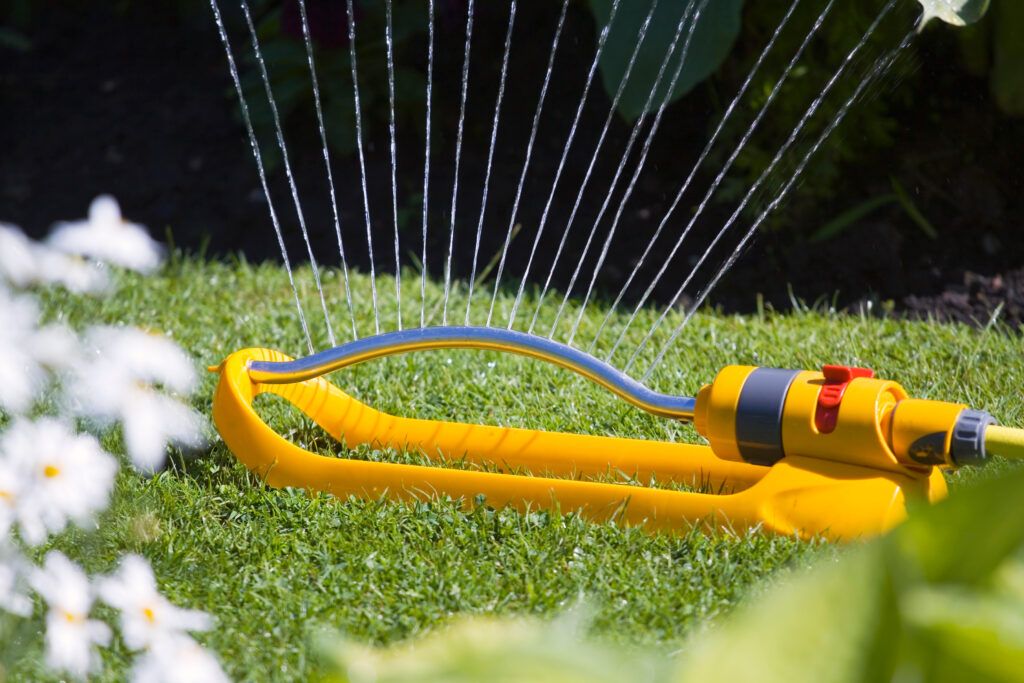
Oscillating Sprinklers
Oscillating sprinklers are a summer favorite. They feature a curved arm that moves back and forth to create an arc of water, making them excellent for rectangular or square lawns. These sprinklers distribute water quickly and are perfect for urban or suburban yards with defined shapes.
- Reach: Up to 70 feet long by 60 feet wide
- Spray pattern: Square or rectangle
- Watering speed: Fast
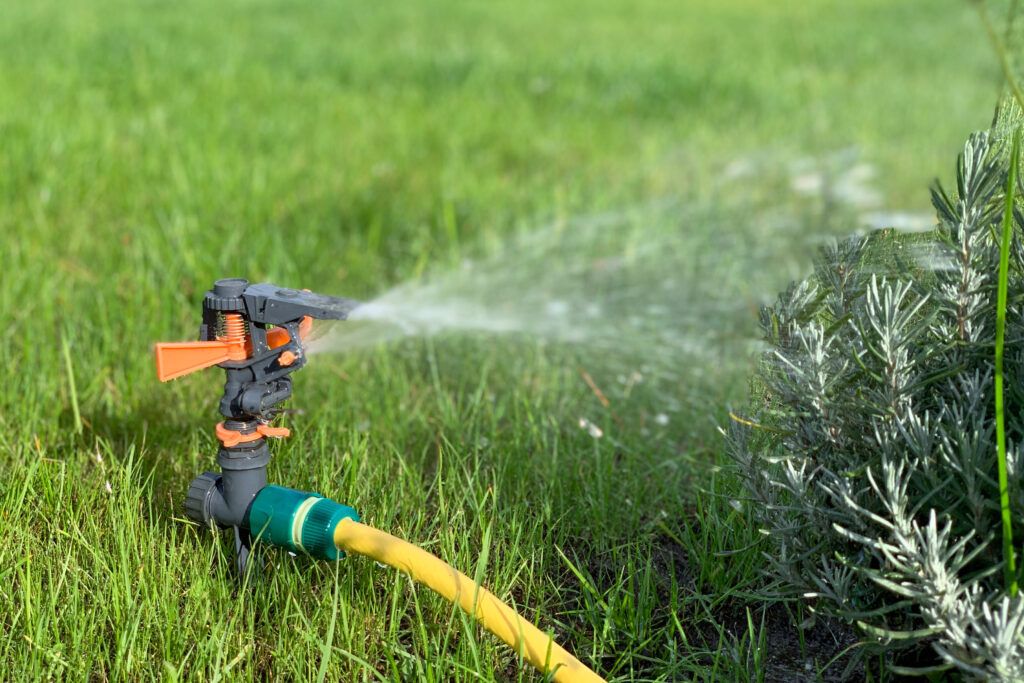
Pulsating Sprinklers
Pulsating sprinklers, also known as impact sprinklers, emit a pulsing stream of water that can efficiently cover large areas. They’re ideal for large yards and areas that don’t drain quickly. Their low-to-the-ground spray pattern also makes them suitable for windy conditions.
- Reach: 85 to 90 feet in diameter
- Spray pattern: Full or partial circle
- Watering speed: Slow
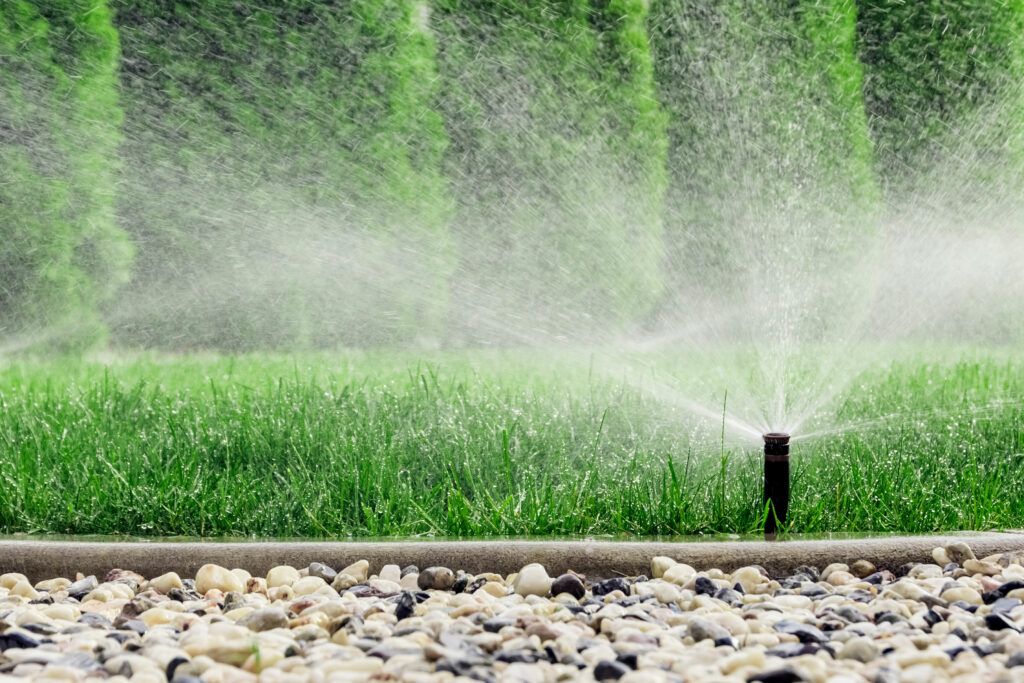
Quiet Rotor Sprinklers
For those who prefer a more peaceful watering experience, quiet rotor sprinklers offer efficient coverage without the noise. These sprinklers are great for large yards that need plenty of water in a short amount of time, and they work well even in low-pressure conditions.
- Reach: 70 to 80 feet in diameter
- Spray pattern: Full or partial circle
- Watering speed: Fast
Multi-Head Sprinklers
Multi-head sprinklers offer customizable spray patterns with multiple adjustable arms. These are perfect for small, oddly shaped yards or specific garden beds that require targeted watering.
- Reach: 10 to 35 feet, depending on water pressure
- Spray pattern: Varies based on arm positioning
- Watering speed: Slow
Walking Sprinklers
Walking sprinklers offer a unique and automated way to water large lawns and gardens. These sprinklers move along the length of a garden hose, propelled by the water pressure, covering a wide area without manual intervention. They are ideal for large, rectangular lawns that require consistent watering without the need for frequent adjustments.
- Reach: Varies with hose length
- Spray pattern: Adjustable arc
- Watering speed: Variable
Sprinklers vs. Sprinkler Systems
When it comes to lawn irrigation, homeowners have two main options: individual sprinklers or full sprinkler systems. Each has its advantages and considerations.
Individual sprinklers are affordable and flexible, allowing you to move them around as needed. They’re ideal for smaller lawns or specific areas that need extra attention. However, they require manual setup each time you want to water.
Sprinkler systems, on the other hand, involve underground piping connected to pop-up sprinkler heads. While more expensive and complex to install initially, the automated watering schedules make them more convenient. For large lawns or those requiring consistent watering, an in-ground system can save time and ensure even coverage, says Roger Cook, landscape contractor for This Old House.
Sprinkler Buying Guide
There are several factors to consider when you’re choosing a sprinkler or sprinkler system. The size and shape of your lawn, what kind of soil you have, and your home’s water pressure can all impact which sprinkler will work best for you.
In the video below, landscape contractor Roger Cook offers tips for choosing lawn sprinklers.
Assessing Your Lawn Size and Shape
The size and shape of your yard play a crucial role in sprinkler selection. For square yards, oscillating or rotating sprinklers with square patterns work well. Irregular shapes might benefit from a walking sprinkler or multiple targeted sprinklers.
Considering Soil Type and Drainage
Your soil’s composition affects how quickly water is absorbed. Clay soils that drain slowly require sprinklers with adjustable flow rates, like pulsating models. Sandy soils that drain quickly might need sprinklers that can deliver more water in less time.
Evaluating Water Pressure and Flow
Check your home’s water pressure and flow rate. High-pressure systems can support larger sprinklers with greater reach, while low-pressure systems might require multiple smaller sprinklers to achieve adequate coverage.
Installing Your Sprinkler System
Whether you’re setting up individual sprinklers or a full system, proper installation is key to efficient watering.
DIY Installation Tips
For standalone sprinklers, ensure they’re positioned to avoid over-spraying onto pavements or structures. When laying out a basic system:
- Map your yard and divide it into zones.
- Choose sprinkler heads appropriate for each zone’s size and shape.
- Connect sprinklers with hoses, ensuring proper overlap for even coverage.
- Test the system and adjust sprinkler positions as needed.
When To Hire a Professional To Install a Sprinkler System
Professional installation is often worth the investment for complex layouts or in-ground systems. Experts can design an efficient system, handle any necessary excavation, and ensure proper water pressure throughout it.
Expert Watering Tips for a Healthy Lawn
Effective use of your sprinkler system is as important as the system itself.
Watering Frequency
Most lawns need about 1 inch of water per week, either from rainfall or from the sprinkler. In temperate climates, this might mean watering every 5-7 days, while hotter, drier climates may require more frequent watering.
The goal is to water deeply but infrequently to encourage deep root growth. Run your sprinklers long enough to moisten the soil 6 inches deep.
Best Time of Day To Water
Early morning, between 4 a.m. and 8 a.m., is ideal for watering, as water has the best chance of soaking into the roots without evaporating. Midday isn’t ideal as water will evaporate, and evening isn’t good either as it can lead to disease in the lawn. Much of the same applies to watering flower, vegetable, and fruit gardens as well. Watering these plants in the evening can spread disease. Watering before 9 a.m. is usually best
Maintaining Your Sprinkler System
Regular maintenance is crucial for ensuring your sprinkler system’s efficiency and lifespan. Here are the best practices for maintaining a sprinkler system.
Regular Inspections
Regular inspections are the foundation of good maintenance practices. Periodically check sprinkler heads for signs of damage, clogs, or misalignment, and clean or replace any damaged parts as needed. Additionally, examine pipes and connections for leaks, cracks, or broken sections and promptly repair any issues to prevent water loss and keep water pressure consistent.
Seasonal Adjustments
Adapting your sprinkler system to seasonal changes is crucial. In the spring, inspect the system for winter damage and gradually open the main valve to prevent pressure surges. During summer, monitor the system frequently to meet the increased water demand and adjust the watering schedule based on weather conditions. In the fall, before the first freeze, drain the system to prevent pipe damage and use compressed air to blow out any remaining water in the lines.
Monitor Water Pressure
Consistent water pressure is vital for the efficient operation of your sprinkler system. Regularly check the water pressure to ensure it is within the recommended range. If pressure fluctuates frequently, consider installing a pressure regulator to maintain consistency and protect system components.
Clean and Replace Components
Clean filters, nozzles, and sprinkler heads are essential to prevent clogs and ensure even water distribution. Periodically clean these components and replace worn seals, gaskets, and valves to maintain optimal performance.
Adjust Sprinkler Heads
Properly aligned sprinkler heads are crucial for efficient watering. Ensure heads are level with the ground and adjust them to avoid watering sidewalks, driveways, and other non-landscaped areas. Set the correct spray pattern and distance to ensure uniform coverage and avoid overspray or runoff.
Winterization
Winterizing your sprinkler system is essential in areas with harsh winters. Before winter, thoroughly drain the system to prevent freezing and pipe bursts. Use compressed air to blow out any remaining water from the system, a critical step to avoid winter damage.
Specialized Sprinklers for Gardens and Landscaping
Specialized watering solutions can provide more targeted irrigation for gardens and landscaped areas.
Soaker Hoses
Soaker hoses deliver water directly to the roots of plants through tiny pores along the hose’s surface, making them highly efficient for deep watering. These hoses are perfect for garden beds and areas where precise watering is needed, such as around shrubs, trees, and delicate plants. They provide a slow and steady water supply, reducing evaporation and ensuring thorough soil saturation.
- Reach: Up to 100 feet
- Spray pattern: Entire hose length
- Watering speed: Slow
Drip Irrigation Systems
Drip irrigation systems provide precise and efficient watering directly to the base of plants. These systems use a network of tubes, emitters, and valves to deliver water slowly and evenly, making them ideal for gardens, flower beds, and vegetable patches. They are especially beneficial for conserving water and minimizing runoff, ensuring each plant receives the exact amount of moisture it needs.
- Reach: Up to 1,000 feet, depending on the system
- Spray pattern: Targeted drips
- Watering speed: Slow
Sprinkler Hoses
Sprinkler hoses provide an efficient and gentle watering solution for garden beds and lawns. These hoses are designed with small perforations along their length, allowing water to be evenly distributed over a designated area. They are perfect for watering long, narrow spaces like flower beds and vegetable gardens, ensuring that all plants receive adequate moisture.
- Reach: Up to 50 feet
- Spray pattern: Straight line
- Watering speed: Moderate
Smart Sprinkler Technology and Automation
Smart sprinkler systems are the cutting edge of lawn and garden irrigation technology, offering convenience, efficiency, and precision. These systems use advanced sensors, weather data, and automation to optimize watering schedules so that your yard receives the right amount of water at the right time. They are ideal for tech-savvy homeowners looking to save water, reduce utility bills, and maintain a healthy, vibrant garden.
Key Features
- Weather integration: Smart sprinkler systems use real-time weather data to adjust watering schedules based on current and forecasted conditions, preventing overwatering during rain or high humidity periods.
- Soil moisture sensors: These sensors measure the moisture level in the soil, ensuring that plants receive water only when needed, which conserves water and promotes healthy root growth.
- Remote control: With smartphone apps, you can control your sprinkler system from anywhere, allowing you to adjust schedules, turn the system on or off, and monitor water usage remotely.
- Zone customization: Smart systems allow you to create specific watering zones, tailoring the watering schedule and amount for different areas of your yard, such as lawns, flower beds, and vegetable gardens.
- Water usage reports: Detailed reports on water usage help you track consumption, identify trends, and make adjustments to save water and lower costs.
- Voice control: Integration with smart home devices like Amazon Alexa and Google Assistant enables voice control, adding an extra layer of convenience to your irrigation management.
Troubleshooting Common Sprinkler Problems
Even well-maintained systems can encounter issues. By regularly inspecting and maintaining your sprinkler system, you can address these common problems promptly and keep your system running efficiently. Here are some common problems and solutions.
Clogged Sprinkler Heads
Dirt, debris, or mineral deposits can clog sprinkler heads, leading to uneven water distribution or no water flow at all.
- Turn off the system and remove the clogged sprinkler head.
- Clean the nozzle and filter screen with water and a soft brush.
- For stubborn clogs, soak the parts in vinegar to dissolve mineral deposits.
- Reinstall the sprinkler head and test the system.
Leaking Sprinkler Heads
Leaks around sprinkler heads can waste water and reduce the system’s efficiency.
- Check for cracks or damage to the sprinkler head and replace if necessary.
- Ensure the sprinkler head is screwed on tightly and not cross-threaded.
- Inspect the seal around the sprinkler head and replace any worn or damaged washers.
Low Water Pressure
Low water pressure can result in weak spray or incomplete coverage.
- Check for partially closed valves or kinks in the hose or pipes.
- Ensure there are no leaks in the system that could be reducing pressure.
- Clean or replace clogged filters.
- If the problem persists, consider installing a booster pump to increase water pressure.
Mismatched or Incorrect Sprinkler Heads
Using the wrong type of sprinkler head for the area can lead to uneven watering.
- Identify the correct type of sprinkler head (e.g., rotary, fixed, drip) for each zone.
- Replace mismatched or incorrect sprinkler heads with appropriate ones.
- Adjust spray patterns and flow rates to match the needs of the area.
Overspray and Runoff
Sprinklers that overspray onto sidewalks, driveways, or streets waste water and cause runoff.
- Adjust the spray direction and radius of the sprinkler heads.
- Use drip irrigation or soaker hoses in areas where overspray is a problem.
- Consider installing sprinkler heads with adjustable nozzles to better control the spray pattern.
Broken or Damaged Pipes
Cracked or broken pipes can cause significant water loss and reduce system efficiency.
- Locate the break by looking for wet spots, pooling water, or unusually green patches of grass.
- Turn off the water supply and dig carefully to expose the damaged section of the pipe.
- Cut out the damaged section and replace it with a new piece of pipe, using appropriate couplings and connectors.
- Test the system for leaks before covering the repaired section.
Faulty Valves
Faulty or stuck valves can prevent water from reaching certain zones or cause continuous water flow.
- Check the valve for debris or damage and clean or replace as necessary.
- Ensure the valve solenoid is functioning correctly and replace if needed.
- Verify the wiring and connections to the valve controller to ensure proper operation.
Inconsistent Watering Schedules
Inconsistent watering schedules can lead to overwatering or underwatering of plants.
- Check the timer and programming of your sprinkler controller.
- Adjust the schedule to match seasonal needs and specific plant requirements.
- Consider upgrading to a smart sprinkler controller that adjusts based on weather conditions and soil moisture levels.
Water Pooling and Puddles
Water pooling around sprinkler heads or in low areas indicates overwatering or poor drainage.
- Adjust the watering duration and frequency to prevent overwatering.
- Improve soil drainage in the affected area by aerating or adding organic matter.
- Ensure sprinkler heads are level with the ground and not tilted.
Who This Sprinkler Guide Is For
Whether you’re a budding DIYer, a longtime homeowner, or somewhere in between, a quality sprinkler can be key to transforming your outdoor space into an oasis. Our team considered a variety of sprinklers, including an oscillating sprinkler, a traveling sprinkler, and more.
How We Selected the Best Sprinklers
To provide our readers with the best sprinkler recommendations possible, we rely on several key sources of information to help guide our selection process.
Initial Research: Our research process began by generating a list of sprinklers with a significant number of verified-buyer reviews and an average customer review rating of 4–5 stars. We looked at positive and negative reviews alike, focusing on information from both satisfied and critical buyers.
Expert Insights: Through our years of experience, we’ve learned that listening to what others have to say is key to building accurate, well-rounded articles. To complement our in-house expertise, our team looked at reviews and videos from trusted publications and independent testers, spoke with subject matter experts, and drew insights from reader contributions.
Final Product Selection: We then began fine-tuning our list by replacing older models with the latest versions and eliminating any discontinued models. From there, we pared the list down further by comparing each model’s feature-set and selecting the best-in-class options for a variety of buyers, budgets, and scenarios.
Why You Can Trust Us
This Old House has empowered homeowners and DIY-ers for more than four decades with top-notch home improvement advice in the form of television programs, print media, and digital content.
Our team focuses on creating in-depth product and service review content. To date, we’ve published countless reviews of garden, lawn, and outdoor products—from fertilizer and garden hoses to patio furniture and snow blowers.
Once we conclude our research, we craft a comprehensive, user-friendly article of recommended products and additional information to help our readers make the right purchase.
Questions or Comments?
To share feedback or ask a question about this article, send a note to our team at reviews@thisoldhousereviews.com.
